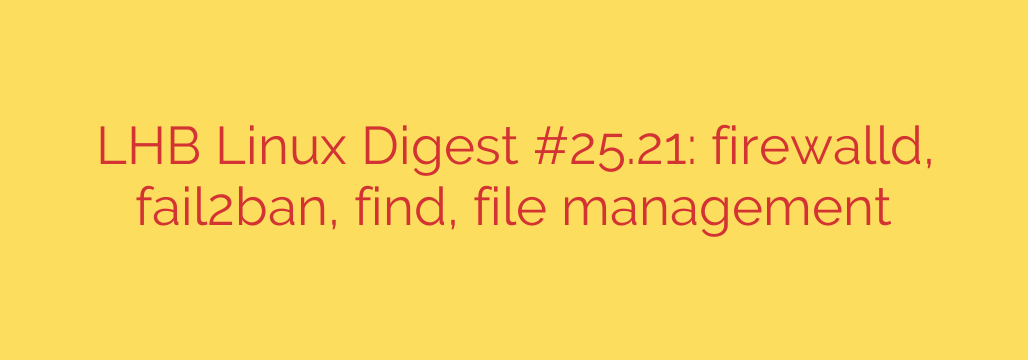
Mastering Your Linux Server: A Practical Guide to firewalld, fail2ban, and Command-Line File Management
For any system administrator, managing a Linux server presents two core challenges: ensuring robust security and maintaining operational efficiency. Mastering a few essential command-line tools can transform these challenges into strengths, giving you granular control over your system’s security posture and file structure.
This guide provides a practical overview of three indispensable tools—firewalld, fail2ban, and the find command—along with fundamental file management techniques. By understanding and implementing these, you can significantly harden your server against threats and streamline your daily administrative tasks.
Fortify Your Perimeter with firewalld
A firewall is your server’s first line of defense against unauthorized network traffic. firewalld is a powerful, dynamic firewall manager for Linux that simplifies network traffic management through the use of zones. A zone is a predefined set of rules that determines the level of trust for a network connection.
Common zones include:
- public: For use in public, untrusted networks. You only want to allow specific incoming connections.
- trusted: All network connections are accepted. Ideal for a private, internal network.
- dmz: For computers in a demilitarized zone that have limited access to the rest of your network.
- home/work: Environments where you generally trust other computers on the network.
By assigning network interfaces to specific zones, you can apply consistent security policies with ease.
Key firewalld Commands
Managing firewalld is done via the firewall-cmd utility. Here are some of the most critical commands:
- Check the status:
sudo firewall-cmd --state - List all rules in the default zone:
sudo firewall-cmd --list-all - Allow a service (e.g., HTTPS) permanently:
sudo firewall-cmd --add-service=https --permanent - Allow a specific port (e.g., 8080) permanently:
sudo firewall-cmd --add-port=8080/tcp --permanent - Reload the firewall to apply permanent changes:
sudo firewall-cmd --reload
Security Tip: Rules added without the --permanent flag are temporary and will be lost upon a reboot or reload of the firewall. For lasting changes, always use the --permanent flag and then run sudo firewall-cmd --reload to make them active.
Proactive Defense with fail2ban
While a firewall blocks unwanted traffic, fail2ban provides an active layer of defense by monitoring logs for malicious activity and automatically banning offending IP addresses. It’s an intrusion prevention framework that protects your server from brute-force attacks, vulnerability scanning, and other automated threats.
fail2ban operates using jails. A jail is a combination of:
- A filter that contains regular expressions to detect malicious patterns in log files (e.g., repeated failed SSH login attempts).
- An action that specifies what to do when a filter is triggered (e.g., ban the source IP address using
firewalld).
By default, fail2ban comes with pre-configured filters for common services like SSH, Apache, and Postfix.
Getting Started with fail2ban
Setting up fail2ban is straightforward. After installation, you should create a local configuration file to override the defaults.
Never edit the
jail.conffile directly. Instead, copy it tojail.local:
sudo cp /etc/fail2ban/jail.conf /etc/fail2ban/jail.localOpen
jail.localwith a text editor and enable the jails you need. For example, to enable SSH protection, find the[sshd]section and setenabled = true.Restart the
fail2banservice to apply your changes:
sudo systemctl restart fail2ban
Actionable Advice: You can customize the bantime, findtime, and maxretry settings in jail.local to define how long an IP is banned, the window of time for detecting failures, and how many failures are allowed before a ban is triggered. Tailoring these settings can create a more effective defense for your specific environment.
Locating Anything with the find Command
As your server’s file system grows, locating specific files can become a challenge. The find command is an incredibly powerful utility that can search for files and directories based on a wide range of criteria, including name, size, type, and modification date.
Common find Command Examples
Find files by name (case-insensitive):
find /path/to/search -iname "filename.log"Find directories only:
find . -type d -name "config*"Find files larger than a specific size (e.g., 100MB):
find /var/log -type f -size +100MFind files modified in the last 7 days:
find /home/user/documents -type f -mtime -7
The true power of find is unlocked when you combine it with the -exec option, which allows you to execute another command on each file found.
For example, to find all .tmp files in your home directory and delete them, you could run:
find ~ -type f -name "*.tmp" -exec rm {} \;
Pro Tip: This is a powerful but potentially destructive combination. Always double-check your find command without the -exec portion first to ensure it’s targeting the correct files before performing an action like deletion.
Essential Command-Line File Management
Efficiently managing files and directories from the command line is a foundational skill for any Linux user. Mastering these basic commands will save you time and provide greater control over your system.
ls -lh: Lists files and directories in a long, human-readable format, showing permissions, owner, size, and modification date.cp -r: Copies files and directories. The-r(recursive) flag is essential for copying a directory and all its contents.mv: Moves or renames a file or directory. The same command is used for both actions.rm -i: Deletes files. The-i(interactive) flag is a crucial safety feature, prompting you for confirmation before each deletion.mkdir -p: Creates a new directory. The-p(parents) flag allows you to create an entire directory tree in one command (e.g.,mkdir -p project/assets/images).
By integrating these fundamental security and management tools into your workflow, you can build a more secure, stable, and efficient Linux environment. Taking the time to master firewalld, fail2ban, and command-line utilities is an investment that pays dividends in both security and productivity.
Source: https://linuxhandbook.com/newsletter/25-21/








